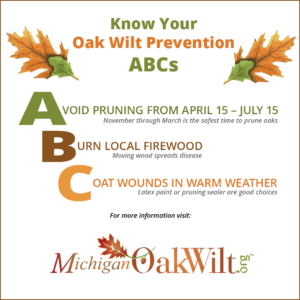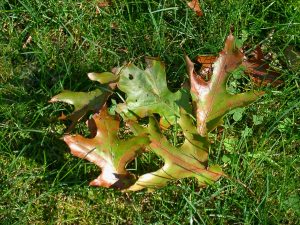As we all continue to spend more time at home because of the COVID-19 pandemic, many of us are using the opportunity to complete projects around the house. And, naturally because the weather is warmer, outdoor projects are high on the list. While most yard projects are beneficial during the spring, there are some—like tree pruning—that can do more harm than good if not done properly.
Although pruning to remove weak, dead or diseased branches can be completed at any time during the year with little effect on a tree, improper or ill-timed pruning can sometimes create lasting damage or even shorten a tree’s life. Wounds from pruning can also promote the spread of diseases like oak wilt.
From approximately April 15 to July 15, oak trees are at highest risk of oak wilt infection, a serious fungal disease that can weaken trees in the white oak group and kill trees in the red oak within a few weeks of infection. It is important that you do not prune oak trees during this high risk period. Pruning or injuring your oaks during this time exposes sap, attracting the nitidulid beetles (also known as picnic beetles) that can carry the disease from infected to healthy trees. Once a tree is infected, the fungus moves to neighboring red oaks through their interconnected root systems. Affected trees will suddenly drop most or all of their leaves; these leaves can be green, brown, or a mixture of the two. If you have a tree that gets damaged during this high risk period, immediately cover all wounds with tree-wound paint or latex-based paint.
 While the above dates are often cited, they are approximate – any time insects are active and sap is flowing, there is some risk of oak wilt transmission. This spring and early summer period is considered the highest risk period due to exceptionally high nitidulid beetle activity. With the progression of summer, beetle activity decreases but does not cease! As our winters warm and dormancy periods for both plants and insects fluctuate, our “safe” window for pruning oaks without use of wound paint fluctuates as well. While not empirical, a good rule of thumb is: if it’s above 45 degrees Fahrenheit, transmission of oak wilt is a possibility.
While the above dates are often cited, they are approximate – any time insects are active and sap is flowing, there is some risk of oak wilt transmission. This spring and early summer period is considered the highest risk period due to exceptionally high nitidulid beetle activity. With the progression of summer, beetle activity decreases but does not cease! As our winters warm and dormancy periods for both plants and insects fluctuate, our “safe” window for pruning oaks without use of wound paint fluctuates as well. While not empirical, a good rule of thumb is: if it’s above 45 degrees Fahrenheit, transmission of oak wilt is a possibility.
Visit the Michigan Oak Wilt Coalition website to learn more about oak wilt. If you suspect your trees have oak wilt, contact the Michigan Department of Natural Resources Forest Health Division: [email protected] or by phone at 517-284-5895. To assess treatment options, visit the Michigan Oak Wilt Coalition’s website to find an ISA Certified Arborist near you.
Related Articles: In 2016 oak wilt was found on Legacy’s Reichert Nature Preserve. An aggressive management plan was implemented to remove diseased trees and stop the spread.
Getting Ahead of Oak Wilt
Staying Ahead of Oak Wilt
Oak Wilt Part III: The Finale (for now)


 RSS Feed
RSS Feed
Thanks for supporting the OW Awareness Campaign!
Several of our efforts were thwarted due to coronavirus, but we hope to repeat the messaging in 2021!